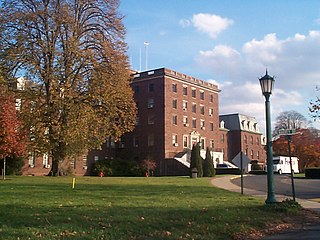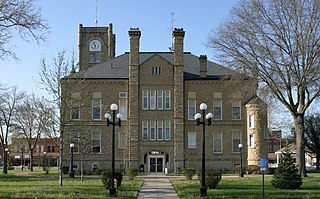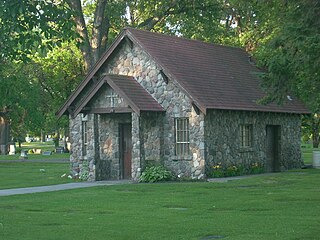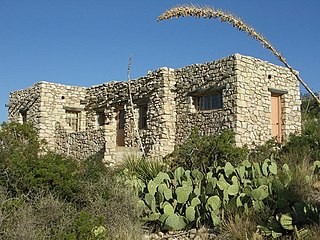
Green-Wood Cemetery is a 478-acre (193 ha) cemetery in the western portion of Brooklyn, New York City. The cemetery is located between South Slope/Greenwood Heights, Park Slope, Windsor Terrace, Borough Park, Kensington, and Sunset Park, and lies several blocks southwest of Prospect Park. Its boundaries include, among other streets, 20th Street to the northeast, Fifth Avenue to the northwest, 36th and 37th Streets to the southwest, Fort Hamilton Parkway to the south, and McDonald Avenue to the east.

Marycrest College Historic District is located on a bluff overlooking the West End of Davenport, Iowa, United States. The district encompasses the campus of Marycrest College, which was a small, private collegiate institution. The school became Teikyo Marycrest University and finally Marycrest International University after affiliating with a private educational consortium during the 1990s. The school closed in 2002 because of financial shortcomings. The campus has been listed on the Davenport Register of Historic Properties and on the National Register of Historic Places since 2004. At the time of its nomination, the historic district consisted of 13 resources, including six contributing buildings and five non-contributing buildings. Two of the buildings were already individually listed on the National Register.

Connecticut Valley Hospital in Middletown, Connecticut, is a public hospital operated by the state of Connecticut to treat people with mental illness. It was historically known as Connecticut General Hospital for the Insane. It is a 100-acre (40 ha) historic district that was listed on the National Register of Historic Places in 1985.

The U.S. National Register of Historic Places (NRHP) classifies its listings by various types of properties. Listed properties generally fall into one of five categories, though there are special considerations for other types of properties which do not fit into these five broad categories or fit into more specialized subcategories. The five general categories for NRHP properties are: building, district, object, site, and structure.

Grand Canyon Village Historic District comprises the historic center of Grand Canyon Village, on the South Rim of the Grand Canyon in Grand Canyon National Park, Arizona. The district includes numerous landmark park structures, many of which are National Historic Landmarks themselves, or are listed on the National Register of Historic Places. The town design as a whole is also significant for its attention to integration with the Grand Canyon landscape, its incorporation of National Park Service Rustic design elements, and for the idiosyncratic design of park concessioner structures such as the El Tovar Hotel.

Munson Valley Historic District is the headquarters and main support area for Crater Lake National Park in southern Oregon. The National Park Service chose Munson Valley for the park headquarters because of its central location within the park. Because of the unique rustic architecture of the Munson Valley buildings and the surrounding park landscape, the area was listed as a historic district on the National Register of Historic Places (NRHP) in 1988. The district has eighteen contributing buildings, including the Crater Lake Superintendent's Residence which is a U.S. National Historic Landmark and separately listed on the NRHP. The district's NRHP listing was decreased in area in 1997.
The University of Arkansas Campus Historic District is a historic district that was listed on the National Register of Historic Places on September 23, 2009. The district covers the historic core of the University of Arkansas campus, including 25 buildings.

The Vander Veer Park Historic District is a historic district in Davenport, Iowa, United States, that was listed on the National Register of Historic Places. Over its 70.8-acre (287,000 m2) area, in 1985 it included 66 contributing buildings, two contributing structures, one contributing site, and one contributing object.

New Mount Sinai Cemetery is a 52-acre (21 ha) cemetery in St. Louis, Missouri. Its first burial was in 1853, and its rural cemetery landscape design was laid out in 1907. It was listed on the National Register of Historic Places in 2005. As of the 2005 listing, the cemetery also has a Modern-style community mausoleum, three private mausoleums, and a formal Japanese garden.

The Lucas County Courthouse located in Chariton, Iowa, United States, was built in 1893. It was listed on the National Register of Historic Places in 1981 as a part of the County Courthouses in Iowa Thematic Resource. In 2014 it was included as a contributing property in the Lucas County Courthouse Square Historic District. The courthouse is the third building the county has used for court functions and county administration.

WPA Stone Structures in Memorial Park and Calvary Cemetery, in Grand Forks, North Dakota, was listed on the National Register of Historic Places in 2010. It includes work by Ray F. Wyrick, "'a noted cemetery landscape engineer' from Des Moines, IA, who consulted as a WPA design advisor all over the country." The listing includes "two sets of stone entrance gateways, one relocated set of stone entry cairns, and a stone chapel building." It is believed that Wyrick made provided overall design of general cemetery layout and designed a reflecting pool for the cemetery, too.

The Caverns Historic District comprises the central developed area of Carlsbad Caverns National Park. The complex was built between the early 1920s and 1942, initially in Pueblo Revival style, and later in New Mexico Territorial Revival style in the area around the natural entrance to Carlsbad Caverns. The earlier structures are built of local limestone, the later buildings in adobe. Thirteen buildings in the district are considered contributing structures. Buildings built between 1940 and 1942 were constructed with labor provided by the Civilian Conservation Corps.

The Lake McDonald Lodge Coffee Shop is a visitor services building in the Lake McDonald district of Glacier National Park, Montana. The coffee shop was built in 1965 as part of the National Park Service's Mission 66 program to upgrade visitor facilities, in order to increase visitor dining capacity. Under the Mission 66 projects, visitor facilities were usually comprehensive in nature, providing a range of visitor services. Specialized concession buildings like the Coffee Shop were unusual in Mission 66. It was leased to the Glacier Park Company for operation, in anticipation of the construction of lodging facilities by the company.

The Royal Neighbors of America National Home, also known as Grandview Terrace, is a nationally recognized historic district located on a bluff overlooking the Mississippi River in the west end of Davenport, Iowa, United States. It was listed on the National Register of Historic Places in 2015. At the time of its nomination, it consisted of eight resources, which included two contributing buildings, one contributing site, one contributing structure, two contributing objects, and two non-contributing buildings. The main building was demolished in 2018.

St. John's Lutheran Church is located in rural Franklin County, Iowa, United States, west of the city of Hampton. The church property was listed as a historic district on the National Register of Historic Places as St. John's Danish Evangelical Lutheran Church in 2015. At the time of its nomination it contained ten resources, which included five contributing buildings, two contributing sites, one contributing structure, one contributing object, and one non-contributing structure.

The Edmundson Park Historic District is a nationally recognized historic district located in Oskaloosa, Iowa, United States. It was listed on the National Register of Historic Places in 2007. At the time of its nomination it contained 52 resources, which included four contributing buildings, six contributing sites, 19 contributing structures, and three contributing objects. There were also 13 non-contributing buildings, five non-contributing sites, and two non-contributing structures.

The West Pleasant Street Historic District is a nationally recognized historic district located in Maquoketa, Iowa, United States. It was listed on the National Register of Historic Places in 1991. At the time of its nomination it contained 50 resources, which included 29 contributing buildings, 21 non-contributing buildings, and one non-contributing site. The historic district is primarily a residential area that was built during Maquoketa's "Boom Years" (1873-1899) and the "Comfortable Years" (1900-1922). The first house built in the district was in 1863 and the last was in 1914. This is where many of the city's business and professional leaders choose to build their houses. Most of the 28 houses were probably not designed by an architect, but were crafted in the "High Style" of the time by local builders. With the exception of Greek Revival, all the major styles of the period built in Maquoketa are found here. Eight of the houses and one of the three remaining carriage houses are brick structures; the rest are wood.

Chariton City Hall and Fire Station is located in Chariton, Iowa, United States. The combination building was designed by city engineer William L. Perkins, who had become known for designing residential and public buildings. The new facility came about because of the inadequate wood frame facilities they shared, and it was underscored by a fire that destroyed the center section of the south side of the town square in March 1930. While its dedication did not take place until March 1932, the city took possession of the completed facility in December 1931. An addition for the fire department was completed in 1979. While the asymmetrical facade and the recessed limestone surround of the main entrance reflects the Art Deco style that was popular at the time, the building's styling reflects the Neoclassical style. It is primarily found in the pilasters that flank the entrance, and the low relief emblems and festoons on the stone panels. The city hall\fire station was individually listed on the National Register of Historic Places in 2006. In 2014 it was included as a contributing property in the Lucas County Courthouse Square Historic District.

Wildwood Park Historic District is a nationally recognized historic district located in Charles City, Iowa, United States. It was listed on the National Register of Historic Places in 1998. At the time of its nomination it consisted of 26 resources, which included three contributing buildings, one contributing site, nine contributing structures, one contributing object, seven non-contributing buildings, and five non-contributing structures.
Carroll City-Mount Olivet Cemetery is a historic site located in Carroll, Iowa, United States. It was listed on the National Register of Historic Places in 2022.





















